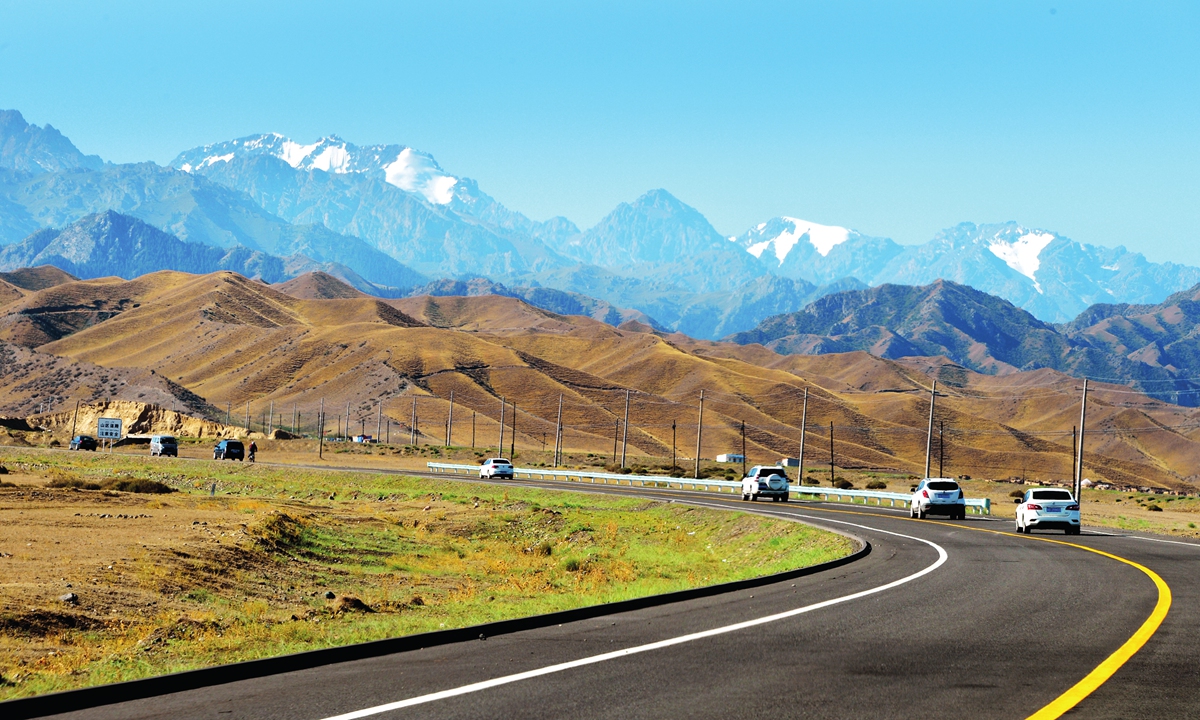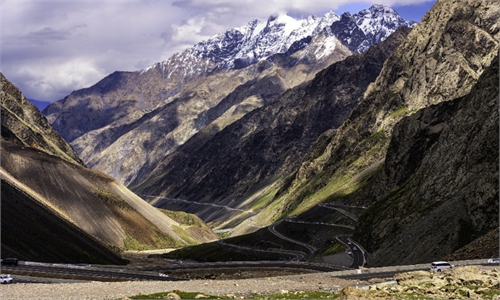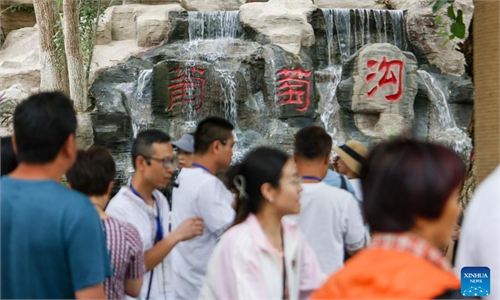
A view of the Duku Highway in Northwest China's Xinjiang Uygur Autonomous Region and the beautiful scenery along the way Photo: VCG
The reopening of the scenic Duku Highway in Northwest China's Xinjiang Uygur Autonomous Region since mid-June has sparked a surge in travel guides sharing and sale of tourism packages.
Travel guides, tips, experiences shared on China's major online rating platform Meituan-Dianping are up 200 percent from a year ago. Xinjiang's travel orders, including hotel accommodation, attraction tickets, transportation, have surged by more than 150 percent compared to the same period in 2019.
The 561-km highway, connecting Dushanzi in the northern area of the Xinjiang region and Kuqa city in the south, runs through a rich variety of landscapes including canyons, glaciers, lakes and grasslands.
It has reopened to traffic on June 18. Due to elements such as snowy weather and road icing, the highway is only open from June to October every year, attracting tourists on driving holidays.
"I am planning a 16-day journey with my family to Xinjiang this summer. Duku Highway will be an important passage linking all these scenic spots in southern and northern Xinjiang," Huang Lan, a tourist from Shanghai told the Global Times.
Unprecedented boom
Xinjiang has enjoyed an unprecedented tourism rebound this year. From January to June this year, Xinjiang received 102 million visits, a year-on-year increase of 31.49 percent, with tourism revenue reaching 92.27 billion yuan($12.82 billion), a year-on-year increase of 73.64 percent, according to data released by the Department of Culture and Tourism of Xinjiang region on July 8.
The popularity of the tourism industry has led to a boom across scenic spots, hotels and the local catering industry in Xinjiang.
After the opening of the Duku Highway, the passenger flow of Bayanbulak Grassland, located alongside the highway has increased significantly.
Passenger flow has jumped from 6,500 patrons a day to 9,000. Average daily passenger flow has increased by about 50 percent compared with the same period in 2019, which is also a record high for recent years, according to local officials.
The Kanas scenic area has entered the peak tourism season in summer. As of July 18, it has received over 1.55 million visits this year, according to local authorities.
As of July 14 the passenger throughput at Xinjiang Airport Group has crossed the 20-million threshold this year, five days ahead of reaching the same benchmark in 2019.
Currently passenger throughput across airports in Xinjiang has recovered to 103 percent of the same time of 2019 while the number of airplanes arriving and leaving Xinjiang has restored to 143.3 percent of the 2019 level, according to local media outlet ts.cn.
To meet elevated traveler enthusiasm, on July 8, Spring Airlines opened a flight route from Shanghai to Turpan, which will operate on a daily basis. The passenger load hit 100 percent on its maiden flight and has been kept at 97 percent, Spring Tour told the Global Times on Monday.
With Turpan as the first stop for Xinjiang tourism, Spring Tours has designed a number of featured theme products, offering photography, parent-child leisure time, and local food and nature experiences.
According to analysis for current bookings, products for the Northern Xinjiang tours, starting with Turpan and covering Ili, Duku Highway and Kanas scenic area, have been favored by different customer groups such as parent-child families, middle-aged groups and the elderly, according to Spring Tour.
Sustainable development
The sudden tourism resurgence however also put pressure on the reception capacity of the region. Several popular attractions have imposed daily visitor limits, and long queues have formed at the entrances of many popular scenic spots.
Wu Bing, a local tour guide told the Global Times he has been working around the clock coordinating vehicles and hotels for his clients in the travel peak since June.
"There has been an influx of tourists in Xinjiang since June. Only the earliest guests every morning can enter, and those who come a little later may be restricted at some scenic spots and wait on 'endless' lines," Wu said.
Also, cost of accommodation and transportation has increased due to high demand. "Cars are in short supply. The same goes for hotels, with prices fluctuating frequently," Wu added.
In order to cope with the peak tourist flow and provide visitors with a comfortable travel experience, a number of places in Xinjiang have introduced measures to limit the prices to ensure the sustainable development.
For example, administrators in Sayram Lake on July 8 promised not to have price increase in tickets, entertainment experience and catering services.
In terms of standardizing the price of accommodation, the Hotel Industry Association of Gongliu county vowed to resolutely investigate and crack down on price gouging. The county stipulated that the price of the first-class hotel should not exceed 600 yuan, the price of a second-class hotel should not exceed 400 yuan, and the price of a third-class hotel should not exceed 300 yuan.
Korla city on July 5 reminded the city's tourist attractions, hotels, farm operators to strictly abide by relevant laws and regulations in setting prices and follow the principles of fairness, legality and honesty.
Xinjiang is one of the top destinations for domestic tourism, and it is hoped that local attractions, hotels will foster a sustainable long-term market, Wu said.


